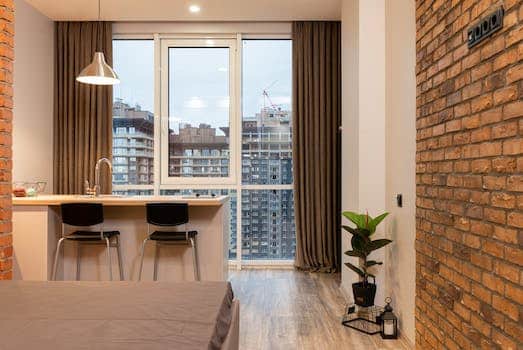Do you wish your walls looked more interesting? A splash of color is a simple way to give your space a new look and feel. Here are several options for painting your interior walls.
- 1. Why adding color to home walls is important
- 1.1. Boosting mood and energy
- 1.2. Creating a focal point
- 1.3. Adding personality to the space
- 1.4. Enhancing the overall aesthetics
- 1.5. Increasing the value of the property
- 2. Choosing the right color scheme
- 2.1. Consider the function of the room
- 2.2. Think about the existing décor
- 2.3. Consider the natural lighting
- 2.4. Choose colors that complement each other
- 2.5. Avoid overwhelming or clashing colors
- 3. Different ways to add color to home walls
1. Why adding color to home walls is important
Changing the color of your home’s walls can have a dramatic effect on the room’s aesthetic. Whether it’s a peaceful blue in a bedroom or a daring red in the dining room, color has the power to provoke a range of feelings and set the mood for the entire room. In addition, painting your walls is a cheap and simple method to give your home a fresh look without breaking the bank on a major remodel. It’s easy to give your walls a splash of color with the wide variety of paints, wallpapers, and wall decorations available today.
1.1. Boosting mood and energy
The psychological and physiological benefits of decorating with color are well-documented. Colors have psychological and physiological effects on humans. Colors like red, orange, and yellow are considered warm, and can be stimulating and energizing, whereas colors like blue and green are considered cool, and can be relaxing. Wall paint color selection can have a significant impact on the mood of your home.
1.2. Creating a focal point
Wall color is an essential part of interior design. The walls of a space are a blank slate where one can showcase one’s unique style and serve as a focal point. The use of color is a powerful design tool; it may be used to create the illusion of more space, or to provide drama and depth to a room of any size. Similarly, the mood of a space can be established by selecting the wall color. Whether you’re a fan of warm and cozy tones or striking and daring hues, painting the walls is a simple method to give your home a unique look and feel.
1.3. Adding personality to the space
Personalizing your home helps it feel more like a reflection of you and your interests and tastes. Putting some color on your wall is one option for doing this. Color can completely alter the atmosphere of a space and stimulate a wide range of feelings. It has the power to transform a room into an inviting retreat. You can make your house feel more like a home by carefully selecting the colors to use throughout.
1.4. Enhancing the overall aesthetics
There’s no doubting that painting the walls of your home may have a dramatic effect on the room’s aesthetics. It may be an expression of your individuality and taste while also giving your home a sense of life and vitality. Whether you opt to paint just one wall or take a more daring approach with the entire room, a fresh coat of paint can do wonders for your home’s aesthetic.
1.5. Increasing the value of the property
Changing the color of your walls is a cheap and easy approach to make your home more appealing to potential buyers. It not only makes your house look more alive, but it also makes guests feel more at ease. The correct color scheme can also make a room appear more expansive than it is. Choosing the proper color paint for your walls can also improve the ambiance and vitality of your home, making it more pleasant to spend time in.
2. Choosing the right color scheme
Wall paint color selection is often viewed as one of the most challenging aspects of interior design. Choosing the right colors for a room can have a significant impact on the way you feel in it. Here are some suggestions for picking the right palette for your house:
One, use a white or other neutral hue as a starting point.
Second, take into account how much light the room gets from windows.
Third, consider the function of the space.
Use colors that go well together 4.
5 Put color to work to draw attention to architectural details.
Make sure the rooms all connect with one another.
7 Think about how colors make you feel.
Don’t be scared to combine different prints and fabrics in a single outfit.
Use contrasting hues as accents.
Ten. Check your color schemes in various lights.
2.1. Consider the function of the room
Wall paint choices in the home should be made with the intended use of each area in mind. A bedroom, for instance, could utilize some soothing, muted colors, while a living area could benefit from some vibrant, eye-catching ones. Once you know what the room is going to be used for, you can start thinking about paint colors. Here are ten suggestions for sprucing up the walls in your own home:
2.2. Think about the existing décor
Consider the room’s current furnishings before settling on a paint color. Your furniture, rugs, curtains, and other home accents should all look good with the paint color you choose for the walls. A room with a neutral sofa, for instance, can benefit from a splash of color on the walls. However, if you have brightly colored furniture, you might want to go with a more subdued wall color for a more tranquil atmosphere. Taking into account the current furnishings will help you choose a color scheme that will complement the home’s style.
2.3. Consider the natural lighting
Wall paint color decisions should be made with the amount of natural light in each space in mind. When choosing a choice, it’s important to remember that natural light can drastically alter the way colors seem. It’s recommended to choose lighter, cooler colors in spaces with lots of natural light so that the eye isn’t blinded. Warmer, deeper hues help create an inviting feeling in rooms with limited natural light. The best color scheme for your home will ultimately be determined by your tastes and the specifics of each area.
2.4. Choose colors that complement each other
Choosing the proper color scheme is essential when painting the walls of your home. Picking out complementary hues is a crucial step in the process. Selecting complementary colors from the color wheel, such as blue and orange or yellow and purple, is a good way to get this effect. Colors that are next to one another on the color wheel can also work well together. You can improve your home’s attractiveness by picking complementary colors to create a unified and balanced design scheme.
2.5. Avoid overwhelming or clashing colors
When picking on a color scheme for your home, it’s best to steer clear of bold or jarring hues. It’s tempting to use a striking color scheme, but in most cases it’s better to keep the main color scheme muted and add interest with accessories. In doing so, you can avoid giving the impression that your area is excessively cluttered or disorganized. You should also think about the lighting in the room, since varied amounts of natural light or artificial lighting can affect how a color appears.
3. Different ways to add color to home walls
Changing the color of your home’s walls is an easy method to make your house feel more like a home. You may add color to your walls in a variety of ways, such as by painting, wallpapering, applying decals, or even creating a mural. In case you’re seeking to give your walls a splash of color, here are some suggestions to think about.
Painting the walls is the most common and time-honored method of decorating a home with color. A variety of colors and textures, from matte to glossy, are available for your selection.
The second traditional method of decorating walls with color and pattern is wallpaper. It’s not as simple to put up as paint, but the end product can be quite magnificent.
Decals are a quick and simple way to add a splash of color to any room. They come in a wide range of sizes and styles, from straightforward geometric patterns to elaborate ornamentation.
A mural is a big painting or design that is painted on one wall and continues around the room. If you want something that will stand out and draw attention, this is it.
Walls that stand out from the rest of the room are called accent walls, and they can be one or many sections of a wall. There will be a pop of color without it being too much for the room.
Sixth, texture can provide aesthetic interest and depth to your walls. You can use textured paint, textured wallpaper, or make your own texture with tools like stencils and sponges.
Stripes are a great way to bring color and design to a room without being too serious. It’s up to you whether you want a more subtle color scheme or a more dramatic one.
Stencils, number eight on the list, are a fun and easy way to decorate your walls. Stencils come in all forms and sizes, and their designs range from floral to geometric.
Hanging multiple pieces of art or photographs together on one wall is known as a gallery wall. Using this method, you can showcase your treasured possessions while also giving your walls a splash of color and character.
Color can also be added to walls by installing shelves. You can either paint the shelves or fill them with books, vases, and photo frames to add color.
3.1. Painting the walls
Painting the walls is a tried-and-true method of giving your home a splash of color. Whether you’re painting an accent wall or the whole space, you have your pick of many different colors. Any room in your house can be given a new look with only a little amount of preparation and some time and paint.
3.2. Using wallpaper or wall decals
Putting up wallpaper or decals on your walls is a quick and simple method to give your home a splash of color. There is a wide variety of styles and patterns to choose from, making it simple to select something that suits your taste and goes well with your current furnishings. Wallpaper and decals, whether in a bold, graphic print or a delicate, understated pattern, are also fantastic ways to add texture and visual interest to a room.
3.3. Adding accent walls or murals
Wall murals and accent walls are fantastic ways to inject some life and personality into your home’s interior. Pick a striking hue to draw attention or a more muted tone to blend in with the existing decor. Murals are a creative method to express yourself and may be a great topic of conversation when you have company over. Whether you do it yourself or hire a professional, painting an accent wall in your home will give it a special look.
3.4. Using stencils or patterns
Decorating your home’s walls with color and design is simple when you use stencils or patterns. There are many different stencil designs available, or you can make your own. Painting over the stencil with a contrasting color is as easy as taping it to the wall. Stripes and chevrons are just two examples of patterns that can be used to liven up a room’s walls. You may easily paint any design you like by taping off sections with painter’s tape. Using stencils and patterns to decorate your home is a great project for the whole family.
3.5. Incorporating textiles or artwork
Adding fabrics or artwork to your walls is a great way to inject some color into your living space. Add texture and color to a wall by hanging a colorful tapestry or blanket. You may also make a piece of artwork that features your preferred hues the showpiece of the area. Handmade textiles, such as colorful carpets and weaved baskets, are also available for use as decorative accents. Don’t be afraid to combine different patterns and textures to make a room look lively and unique.
Conclusion
Adding splashes of color to your home’s walls can be an exciting and original way to spruce up your living quarters. Here are 10 ways to inject some color into your home and show off your unique sense of style.






These 10 innovative and imaginative DIY home decor ideas from [object Object] provide a refreshing approach to enhancing ones living…